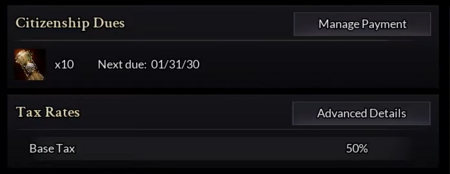Difference between revisions of "Node layout and style"
(Add section) |
(Add section) |
||
| Line 21: | Line 21: | ||
{{Racial quests}} | {{Racial quests}} | ||
| − | == Node | + | == Node destruction == |
| − | {{Node | + | {{Node destruction}} |
| − | == | + | === Node redevelopment === |
| − | {{ | + | {{Node redevelopment}} |
== See also == | == See also == | ||
* [[Node advancement]] | * [[Node advancement]] | ||
| + | * [[Node destruction]] | ||
* [[Node sieges]] | * [[Node sieges]] | ||
* [[Progression]] | * [[Progression]] | ||
Revision as of 19:13, 31 October 2020
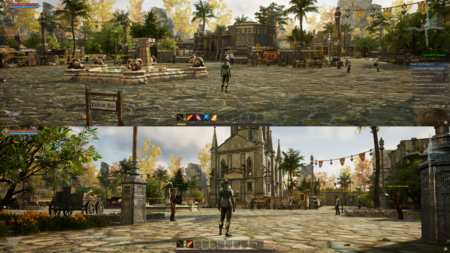
The layout and architecture within a Node’s development area are determined by influential race. For example, a stage 3 Node with the majority of player contribution being Py'rai would have a Py'rai village with Py'rai architecture. Most NPCs would be Py'rai elves, and offer questlines within the Py'rai narrative.[1] – Margaret Krohn
Each player’s contributed experience is flagged with their character race and other identifiers. When a Node advances, the race with the highest experience contribution determines the Node’s style and culture. This style and culture change can happen at every Node Stage. For example, if a Node advances to Level 2 - Encampment Stage and 51% of all experience was earned by Ren’Kai players, the Node will be a Level 2 Ren’Kai Node. If that same Node advances to a Level 3 - Village Stage Node, but the Py'Rai contributed 62% of all the experience earned, then the Node will be a Level 3 Py'Rai Node.[2] – Margaret Krohn
Node layout and style is determined by several factors:[3][4]
- The way that the node system is built is that they can exist across a spread of 18 biomes, but at the same time have to represent the cultural influence of these cultures that are intrinsically a part of a specific biome.[5] – Steven Sharif
- Environment (biome) and location of the node.[5][3][4]
- Nodes will adjust the local topography to fit the aesthetic and mechanical requirements of the node.[6]
- Currently the way that the platform system is set up, is it's capable of adjusting the topography of the node's footprint, regardless of the surrounding terrain. So the reason for that is we want to have flexibility in the presentation of the node's layout and how it is essentially both from an aesthetic standpoint as well as a mechanical standpoint with node sieges- how it's constructed and that construction should have the ability to take on a variance of different types of topography. So it shouldn't be dependent on the surrounding area. Now that's not to say that the surrounding area isn't going to have some influence over. So for example... we're experimenting a little bit with the platform tech and putting up a node up against the side of a mountain or on the edge of a cliff or something that has a beautiful vista. Those are things that we're going to test out obviously as we continue to work on the node tool and how that platform system works, but the idea is to have the node independent of the surrounding terrain.[6] – Steven Sharif
- Some parts are determined by the area it's in. Some parts are determined by the type it is. Some parts are determined by the race it is; and then the rest of it is determined by the mayor.[4] – Jeffrey Bard
- Race that contributed the highest percentage to the node's advancement will alter the racial appearance of its buildings, NPCs, and props.[7][8][3][2][4][9][10]
- All nodes, whether they're associated with a castle or associated with normal node structure, has cultural influences that replicate over to the buildings that are produced and the NPCs that are present.[12] – Steven Sharif
- The rest is determined by the node's mayor.[4]
- It should be possible for a node to complete several building projects within a mayor's one month term in office.[13]
- Q: How long would you say it will take players on average to fill/build up a node completely from wilderness to metropolis?
- A: It's one thing to get a node to a certain level: it's another thing to develop the node; and I can't really give you an on-average expectation, because there's a lot of variables at play. There's how many citizens does the node have attracted to it; what's the type of traffic that the node is attracting to it based on things like its tax rates, or the specialization that it chose to spec into, based on the building types it's chosen to build. All of those things are variables that can affect the quote-unquote "average build-out time" of a particular node. So it's difficult to give you an average when there's so many variables along those lines. But the idea is that if there is a particular project that players are interested in in developing based on the node stage, that they would have the ability to complete several of those projects as within a single term of a mayor; and a term of a mayor is one month.[13] – Steven Sharif
Taxation
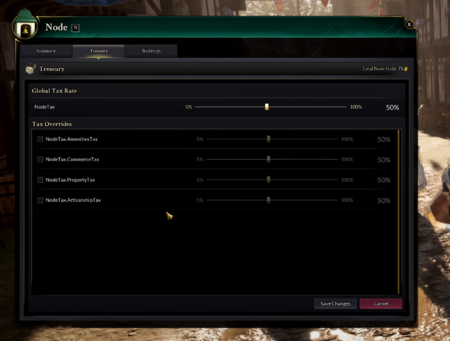
As the node levels up, you're gonna get access to deeper controls on the taxes, so that you as a Mayor can incentivize players to come to your node to do certain things. If you're a node that loves smithing, you're probably going to want to lower your taxes on artisanship to incentivize players to be here. But then you might want to drive up taxes on other avenues that players aren't necessarily coming to your node for, but are using out of convenience.[14] – Chris Justo
Mayors are able to set a generalized node tax rate as well as overrides for different activities within their node. Mayors gain additional taxation controls as their node advances.[14][15]
- Amenities tax override.[14]
- Artisanship tax override.[14]
- Commerce tax override.[14]
- This may include taxes that apply to tavern games.[16][17]
- Property tax override.[14]
- Freehold property taxes scale according to the number of freehold building permits issued for that freehold.[18][19][20]
- Citizenship dues and property taxes scale based on the stage of the node when a player became a citizen.[21][22][23][24][25]
- The goal is to exert financial pressure on node populations by making taxes increasingly expensive as nodes advance, rather than putting in place hard population caps.[23][24]
- Node tax rates will be visible on the world map by hovering over a node location.[26]
- Tax revenue only goes toward funding node development. This cannot be withdrawn by the mayor or any other player.[27][20]
Regent nodes take a cut of taxes from various activities that occur within their vassal node structure.[27][28]
- This tax doesn't necessarily impact the individual citizen, because citizen's tax levels are determined by their node, but the node's finances are affected by the taxation levied by its parent nodes.[28]
Node buildings
Constructible node buildings
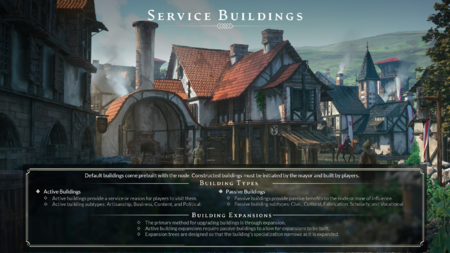
The important thing with the service building system for us is that it's a way to shape your node like a character; and to give you an exclusive niche that you can carve out in the world; or a niche that you fight over. If you go down this weaponsmithing path and you build your node to be this mecca of weaponsmithing and the node three doors down builds it, there's reason for you to conflict over it. They're taking your business. Or maybe you are in a zone and there isn't a weaponsmithing thing anywhere near you, and you do want to start to carve that path for yourself to make your node a place people visit and come to.[29] – Chris Justo
Service buildings within a node are either default buildings that come with the node, or they are constructed buildings, which are initiated by the mayor and built by players.[21][29][30][31][32][33][34] Service buildings are further broken down into two main types:[21][29]
- Active service buildings are service buildings that players directly interact with. These are further broken down into Artisanship, Business, Content, and Political categories.[21][29]
- Passive service buildings provide passive benefits to the node or its zone of influence. These buildings are broken down into Civic, Cultural, Fabrication, Scholarly, and Vocational.[21][29]
- Constructed service buildings are available to every type of node in every location. Where the uniqueness comes in is in some of the default buildings like your node-type building.[35] – Chris Justo
Service buildings are upgraded by expansions, which are unlocked through the placement of passive service buildings.[21][29]
- Building expansions unlock higher tier workstations at the cost of dedicating service building plots.[36][32]
- Node service building expansions specialize the building through a tech tree based on the stage of the node.[37][38]
Service buildings incur a regular maintenance cost of node commodities and gold from the node treasury in order to continue operations.[21][39]
Unique node buildings
Each node type has a unique service building associated with it that can be activated at Village (stage 3) of node advancement.[35] The unique building plays a central role in the progress of civilization for a server.[41]
Racial quests
Quests may be based on a character's race.[42]
Different quests may relate to who the primary cultural contributor is to a node. This won't lock out content, but will add flavor to the quests.[42]
There might even be different directories of the quest that exist for specific races, and even though you're sharing a quest to kill a boss, if you're human and I'm an elf, I will have a different arc potentially that leads in a different direction than you, even though we took the same quest; and this can relate to who the primary cultural contributor is to a node unlocking different arcs for cultures that share the primary culture of a node - not that locks out content but it gives a flavor in a different direction so that not everything is so cookie cutter.[42] – Steven Sharif
Race matters because narratives have paths that also are influenced based on the primary contributing culture to the node... If you're a Niküa and you have you're in a Niküa node that's predominantly Niküa, you're going to have certain services and/or abilities as a member of the Niküa race that other races may not have access to... They may have alternative quest lines, but they won't have specific ones. Now those specific Niküa quests will then relate to the meta-narrative that's present in the world and they'll start to direct some of that meta-narrative; and that'll be beneficial for your kind because it will unlock certain content for your race that other races haven't unlocked yet. So there is an incentive there to see progression along that line now in order to curb the progress of a dominant race.[43] – Steven Sharif
Quests that are race specific, title specific, or guild specific will likely be less than 10% of the total number of quests. 90% of quests should be able to be shared by everybody.[44]
Node destruction
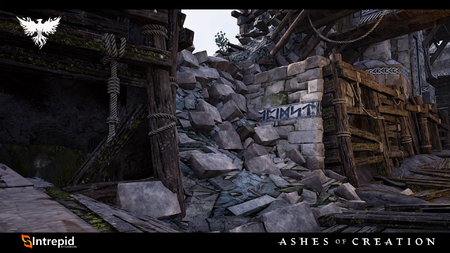
Nodes can be destroyed starting at Level 3 - Village Stage, and are destroyed through sieges. Sieges are started via an item which is acquired through a quest that scales in difficulty with respect to the level of the Node which is being targeted for the siege. Once the item is brought to the Node and is activated, the declaration period begins and a countdown is initiated for players in the region to see. This countdown runs for a number of days equal to the level of the Node being sieged. Once the countdown is complete, the siege begins. There is a cooldown between sieges, and players must wait a certain amount of time after an unsuccessful siege before a new siege can be declared. The higher the Node level, the longer the cooldown between sieges. If a siege is successful, then the Node is brought down to Level 0, and anyone who was a citizen of that Node is no longer a citizen.[2] – Margaret Krohn
Nodes can be destroyed starting at Village (stage 3) following a successful siege against that node.[2]
- It is a normal process of the world to see PvP be a catalyst for change. That is one of the defining elements of our world building approach and being a PvX game is that PvE builds the world and PvP changes the world; and as these nodes get destructed this should be a normal habit that players are accustomed to seeing that landscape changing over time, because it is the breath of renewal that then is allowed as a result of that action.[45] – Steven Sharif
- Players lose their node citizenship after their node is destroyed without entering into a cooldown period.[45][46][2]
- Node destruction may prevent some quests from being completed.[47]
- After a node is destroyed, the footprint of the node will enter a ruined state and will become an open PvP zone for a number of days equal to the node's level. These ruins consist of a debris field of treasures that are lootable by certain players.[48][49][50][51][52][53]
- Which players get to loot the debris field during this period is currently under discussion by the developers.[54] Previously it was stated that any player could loot the debris field.[49] Before that it was stated that only attackers who participated in the siege will have exclusive looting rights.[55]
- Any loot remaining after this period will be open for anyone to loot.[55]
- After a number of days equal to the destroyed node's level, the node will revert back to stage 0 (wilderness) and any modified terrain will revert back to its original state.[49][56][57]
- Those are like open-world battlegrounds that spawn on the footprint of the node after a successful siege. And these are opportunities that previous defenders have to salvage certain materials and/or equipment from the destroyed node, or that attackers have to do the same. And there's interact points that live within that environment that take time in order to interact with, which makes those individuals susceptible to potential ganking or fighting. And you can control those areas; and that exists for some period of time. It's like an open-world arena system.[48] – Steven Sharif
- Treasures in the debris field will take time and tools to uncover.[48][49]
- The warehouse debris will contain a portion of all Materials (crafting components) and Gatherables that were stored in the destroyed node.[49][50][51][52][53]
- The reliquary debris will contain a stockpile of shards of the relics that were stored there.[58][49][50][59][60]
- The town hall debris might contain tax-oriented certificates that were held within the vaults and in the treasury.[50]
- The stables debris might contain mount certificates that can be added to caravans in the future or sold on the auction house.[50]
- Gatherables and crafting materials that were stored in in-node housing and apartment storage chests become lootable. These are not lootable if the node survives the siege- even if the housing buildings are destroyed or damaged during the siege.[51]
Node redevelopment
A node that was successfully destroyed by a node siege may develop differently due to the following influences:[3][61]
- Different races becoming primary contributors.[3][61]
- Design elements determined by different governments.[3][61]
- Reactions and interactions with other nodes in the world.[3][61]
See also
References
- ↑ Blog - Know Your Nodes - The Basics.
- ↑ 2.0 2.1 2.2 2.3 2.4 2.5 Blog - Know Your Nodes - Advance and Destroy.
- ↑ 3.0 3.1 3.2 3.3 3.4 3.5 3.6 Livestream, October 30, 2020 (39:17).
- ↑ 4.0 4.1 4.2 4.3 4.4 4.5 Livestream, September 27, 2018 (53:06).
- ↑ 5.0 5.1 Livestream, February 25, 2022 (41:00).
- ↑ 6.0 6.1 Livestream, February 26, 2021 (1:12:18).
- ↑ Livestream, March 31, 2022 (4:57).
- ↑ Podcast, April 11, 2021 (29:47).
- ↑ Interview, May 11, 2018 (54:34).
- ↑ Livestream, May 26, 2017 (21:23).
- ↑ Podcast, April 11, 2021 (23:36).
- ↑ 12.0 12.1 Interview, May 11, 2018 (47:27).
- ↑ 13.0 13.1 Livestream, July 29, 2022 (1:13:09).
- ↑ 14.0 14.1 14.2 14.3 14.4 14.5 14.6 14.7 Video, August 31, 2023 (28:04).
- ↑ Livestream, March 28, 2020 (1:03:38).
- ↑

- ↑

- ↑ Interview, July 9, 2023 (54:46).
- ↑ Livestream, June 30, 2023 (1:45:22).
- ↑ 20.0 20.1

- ↑ 21.0 21.1 21.2 21.3 21.4 21.5 21.6 21.7 Blog: Development Update with Village Node.
- ↑ Livestream, August 31, 2023 (15:51).
- ↑ 23.0 23.1 Interview, July 9, 2023 (38:14).
- ↑ 24.0 24.1 Interview, March 27, 2020 (0:30).
- ↑ Video, April 5, 2018 (41:48).
- ↑ Livestream, September 29, 2023 (1:11:22).
- ↑ 27.0 27.1 Livestream, August 26, 2022 (1:10:16).
- ↑ 28.0 28.1 Interview, May 11, 2018 (57:02).
- ↑ 29.0 29.1 29.2 29.3 29.4 29.5 29.6 Livestream, August 31, 2023 (50:25).
- ↑ Video, August 31, 2023 (2:59).
- ↑ Interview, July 9, 2023 (1:32:45).
- ↑ 32.0 32.1 Livestream, May 19, 2017 (33:57).
- ↑ Livestream, January 20, 2018 (38:17).
- ↑ Livestream, 2018-04-8 (PM) (51:49).
- ↑ 35.0 35.1 Livestream, August 31, 2023 (56:18).
- ↑ Livestream, August 31, 2023 (52:56).
- ↑ Video, August 31, 2023 (34:37).
- ↑ Livestream, March 31, 2022 (1:13:00).
- ↑ Livestream, August 31, 2023 (57:23).
- ↑ Livestream, September 1, 2018 (36:28).
- ↑ Know Your Nodes: Economic Node Type.
- ↑ 42.0 42.1 42.2 Podcast, April 23, 2018 (29:56).
- ↑ Interview, May 11, 2018 (1:00:19).
- ↑ Livestream, July 26, 2019 (1:13:23).
- ↑ 45.0 45.1 Livestream, August 31, 2023 (20:54).
- ↑ Interview, July 29, 2020 (17:26).
- ↑ Livestream, February 29, 2024 (53:58).
- ↑ 48.0 48.1 48.2 Interview, July 9, 2023 (1:36:24).
- ↑ 49.0 49.1 49.2 49.3 49.4 49.5 Livestream, October 14, 2022 (52:31).
- ↑ 50.0 50.1 50.2 50.3 50.4 Podcast, September 29, 2021 (14:21).
- ↑ 51.0 51.1 51.2 Interview, July 8, 2020 (57:46).
- ↑ 52.0 52.1 Livestream, April 30, 2020 (1:14:44).
- ↑ 53.0 53.1

- ↑ Livestream, July 28, 2023 (1:26:16).
- ↑ 55.0 55.1 Podcast, September 29, 2021 (15:46).
- ↑ Livestream, June 26, 2020 (1:48:43).
- ↑

- ↑

- ↑ Podcast, September 29, 2021 (10:49).
- ↑ Interview, July 18, 2020 (56:11).
- ↑ 61.0 61.1 61.2 61.3 Livestream, May 24, 2017 (52:39).
